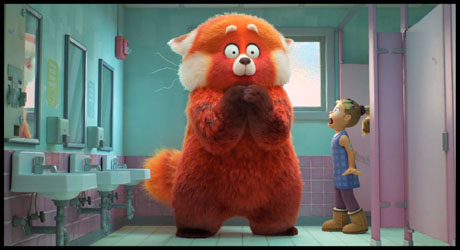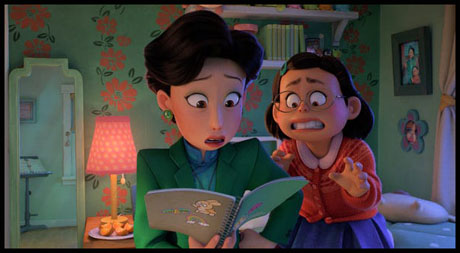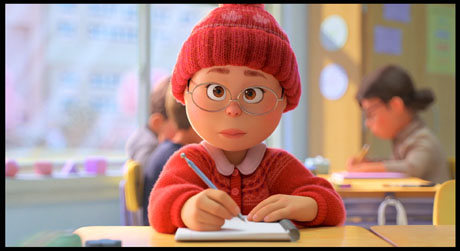
Academy Award winning director Domee Shi (short “Bao”) and producer Lindsey Collins team-up for Pixar’s new feature Turning Red. It debuts this Friday March 11th on Disney+ and in **three** select U.S. theaters. Shi and Collins discuss this, as well as specific scenes and core themes in this Animation Scoop Q&A.
Jackson Murphy: Domee, congratulations on the film not only being on Disney+ but in theaters at the El Capitan in Hollywood and the AMC Empire 25 in NYC. How does that feel?
Domee Shi: Wahoo! Yes. I’m so excited. If there’s any way you can watch it on the big screen, please do, especially the last third of the movie. It’s epic.
Lindsey Collins: It’s also playing for one week in Oakland, CA, which is kind of our home town at Pixar. So it’s super fun that we’re gonna get to go and watch it with friends and family. The actual fact that so many people are gonna have the opportunity to watch it in their homes right away is equally exciting.

DS: It’s awesome.
JM: Fantastic. Since it’s set in 2002, so much of the movie, especially with the spirit of boy bands, is all about nostalgia. Lindsey, what do you think the fascination is that people have with nostalgia, especially when it comes to the entertainment world.
LC: I think people like to be transported to different times and places, whether those are real times and places or fictitious or fantastical ones. There’s something about the early 2000’s, though, that has such specificity to it. There’s a style to it with all the technology and the music. Part of what the attraction was was not only obviously Domee grew up in that time but it was also a time before social media. And when you’re talking about girls — or anybody — coming of age, in terms of personal relationships with family and friends, it’s really simpler to attack it and talk about it prior to social media. What was really influencing kids during that time? There was something really fun about that.
JM: It’s a fun movie with a lot of heart — and you’re right, especially towards the end. And a deep theme I found, Domee, is using someone for what they can do vs. who they really are. You explore that with Mei turning into the panda and her friends. How and why did you really want to express that theme?
DS: Especially for girls… but kids are taught at a young age [that]… in order to fit in and move through society in an easy way, you have to push down or get rid of all the nastiness inside of you. Sit up straight. Speak softly. Be polite. Don’t show too much emotion or anger. What I love about this movie and Mei’s journey is that she kind of learns to embrace all of the messiness of herself and growing up and life. And hopefully audiences are encouraged to do that too. I love that because growing up I wish I had a movie that could encourage me to embrace that messiness inside of me. Especially for girls, there’s such a focus on perfection: being small, perfect and quiet. With this movie, we’re saying the exact opposite.

Domee Shi, Lindsey Collins, Jackson Murphy
JM: There’s no doubt that kids are going to relate to this and really connect to this story. One of the scenes that really got me involves Mei’s mother blaming her friends instead of blaming her. We’re not gonna give away the reasons why. Lindsey, tell me about putting that scene together… because I think that’s a dramatic turning point in this and one of the standouts in the film.
LC: It is. It is the moment when our character is forced to choose — the first moment when she’s forced to choose. Deciding to stay her mom’s perfect little girl and keep that facade up, or to side and defend her friends and be honest about who she’s become and her responsibility in all of it. We love that we made the choice that she, arguably, makes the wrong choice and isn’t ready yet at that point in the movie to fully come clean or come out to her mom about all of the things that she’s going through and struggling with. It is the moment in the movie where you see Mei at her lowest. She’s realizing as she’s doing this that people who have supported her and have become the most important people to her (her friends): she has just literally thrown them under the bus. She knows she’s making the wrong decision as she’s doing it, but the desire to please her mom is still too strong for her to stand up. That’s a VERY perfect scene where the full tension of those two pulls on a girl’s life is coming head to head.

JM: Tension is the perfect word there. Domee, there are several scenes in the film that happen and then they’re inserted into a video camera. I assume you have to finish those scenes first to then put them into the video camera. But how exactly does that work?
DS: It took a very talented crew! (laughs) Our DP Mahyar [Abousaeedi] unearthed an old Sony video cam from the early 2000’s. And we actually shot some reference footage and played around with it to see what the filter would like. All of that you’re able to do on the computer.
LC: We call them “picture in picture”. And they count. Those scenes count as actual shots in the movie. You have to animate them as though they were shots that you see fully in the movie before you put them on the screen in the video camera. They don’t come for free.

JM: Very cool. Can you talk about the fantasy, reality and spirituality themes all colliding, especially towards the end of Turning Red? I think that’s also what’s going to stand out for families.
DS: The movie is about this girl struggling between these two worlds (eastern and western / kid and adult / panda and human). What you’re gonna see at the end is all of that coming together in a really, really satisfying and surprising way that helps show her that life is not black and white and you don’t have to be one or the other. You can honor both sides of yourself. You can honor the light and the dark.
- INTERVIEW: Jeff Fowler On “Knuckles” And “Sonic 3” - April 22, 2024
- INTERVIEW: “Inside Out 2” Director And Producer On Pixar Sequel - April 16, 2024
- INTERVIEW: “Puffin Rock And The New Friends” And 25 Years Of Cartoon Saloon - April 10, 2024


 March 7th, 2022
March 7th, 2022  Jackson Murphy
Jackson Murphy  Posted in
Posted in  Tags:
Tags: 






